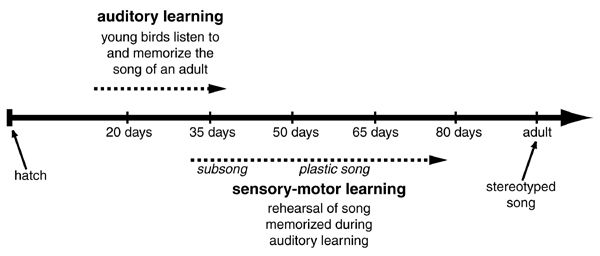The
Animal We Study
Work
in our lab focuses on a songbird, the zebra finch. We are interested in zebra
finches because like humans, they must learn to vocalize in order to communicate with one
another. As with human language, zebra finch song patterns are learned during
sensitive periods of early development.
Another
important aspect of zebra finch vocal behavior is that only males sing. Song is used
by males to court females, but they will also sing spontaneously, even when no females are
present. Young males learn to sing by imitating their father's song. In this
way, song patterns are passed from generation to generation.
Song
learning involves several cognitive processes. Juvenile males must attend to, hear,
and memorize the song pattern of an adult male (termed ‘auditory learning’).
Later in development, birds practice in order to learn to reproduce the song memorized
earlier in life, a process that requires auditory feedback and auditory-motor integration
(termed ‘sensory-motor learning’). Shown below is a timeline of zebra finch vocal
development. Note that as male zebra finches reach adulthood (80-100 days of age), their
vocal patterns crystallize. As adults, they cannot learn a new
song.

Below are audiospectrograms produced by a male zebra finch (G174) at
different stages of sensory-motor learning (click
on each audiospectrogram to hear it).
Sensory-motor learning begins with subsong, characterized by the production of highly
variable song syllables and syllable sequences. Subsong is considered analogous to the vocal
babbling produced by human infants. G174 was 42 days of age when this recording was
made.

With practice, juvenile birds develop plastic song, where specific
song syllables and a syllable sequence begin to emerge. Syllables that will be included in the
final adult song are evident, but sequencing errors are common. These errors are
similar to the phonological mistakes made by young children as they learn a language. G174 was 60 days of age when this recording was
made.

As
zebra finches reach adult song, individual syllables and the syllable sequence
become stereotyped. Here, three introductory syllables preceded three renditions of the
song pattern. G174 was 127 days of age when this recording was made.

Much of the neural circuitry that controls juvenile learning and adult recitation of song is known.
Interestingly, this circuitry is reduced in size or absent in non-singing females.
Together, these features make the zebra finch a uniquely-useful model system to study
interactions between early experience and brain development, development of sex
differences in brain and behavior, and neural mechanisms of learning and memory.
|